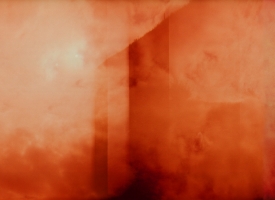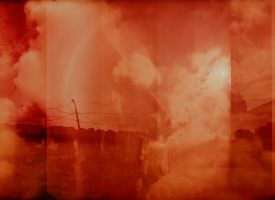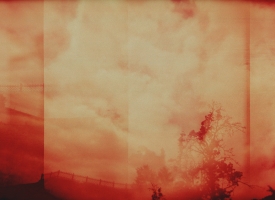TEREZIN / THERESIENSTADT
Project Description
TEREZIN / THERESIENSTADT surrounds the site in the current Czech Republic where the Nazi SS and Gestapo imprisoned, tortured and murdered hundreds of thousands of people. The concentration camp served a unique purpose as the primary torture, transport, and execution facility for Europe’s leading artists and intellectuals (who were also, of course, Jewish). Artists, writers, scientists, scholars, composers, and intellectuals were gathered there for a sadistic display of Nazi cultural cleansing. Today, the 18th century Bohemian fortress and garrison requires visitors to pay an admission fee – except for the swallows, who have set up an intricate community of nests and perches in the torture chambers and crematorium.
Artist Statement
In 2010, Theresienstadt bore the visible bruises of a sadistic human brutality that to me, felt permanent. The human prisoners have all been murdered and their bodies removed, in one way or another, yet their grief and pain continue in visible, enduring scars on the earth itself. I walked through the site at the height of summer, and nonetheless the tall grasses and flowers fell back from the massive gouges in the earthwork embankment at the execution range – craters from bullets that murdered thousands. Standing in the torture rooms – where the youngest victim had been a four year old boy – tiny birds have built mud-daubed nests on the bars and hinges and upper corners. Their nests are likewise affixed to the labrythine gas pipes of the crematorium. Their brown and white waste trails down the walls and into the ovens in a smear of sludge. In the hot afternoon of August, their wings fluttered against the walls as they dove towards the bodies of insects trapped behind the broken glass.
Visual Art
All photographs were at the site of Terezin / Theresienstadt, using a salvaged film cameras manufactured by forced labor during the German occupation of Czechoslovakia.
The colors, textures, shapes and multiple layers within the photographs are all created using only the unique aberrations of the camera’s optics, and the chemistry of the film. There is no software or computer manipulation in the images.
THUMBNAIL GALLERY BELOW. CLICK TO VIEW FULL-SIZE PANORAMIC IMAGES.
Literature
from the essay FIELD NOTES: SWALLOWS AT THE CREMATORIUM
by Quintan Ana Wikswo
First published in Bumblemoth
NOTES FROM A YEAR AFTER….
It’s been exactly a year since I went to Terezin/Theresienstadt Concentration Camp in Czech Republic. At the time, the experience was beyond words…I only made small photographs by pointing the camera at random spaces and clicking the shutter. I was absorbed by the swallows in the torture chambers, and then in a sense, I lost consciousness.
I wondered if the experience of being there would stay that way, and it has.
In hindsight, it was a point after which I was different, and I could talk about that better than I could talk about the experience itself.
I made snapshots of the swallows who nested in the valves and knobs of the crematorium and the latches of the torture chambers. The youngest person tortured here was four years old.
The triptych of photographic work I made with the old cameras – it shows next month at Yeshiva University Museum in New York. To me, that feels like the angry and grieved tribute I longed to make. But it’s not otherwise helpful, emotionally. These…the birds…the knobs…the avian feces covering a profane and sacred place…all this still comes closest to that.
I think daily of these birds and what I hope is their role on this sad planet. People speak about how perhaps they are angels, with their wings wiping away the tears of those who were murdered here. It’s a trite and sentimental thought, but everyone seems to pass by the thought on their way across the tour of the concentration camp.
More uselessness. But there’s a fierceness behind the sentiment that must be covered up, because alongside my ferocity is its companion: the longing to swaddle, too, to wrap up in soft white cloths and soft songs and prayers and offer loving.
And the birds seem to offer both. Claws and beaks, as well as feathers and wings.
I remember, near the end of the visit to the camp, a group of young boys who left the education room ridiculing the Jews who were crying inside. Oh, the sad Jews, they said, rubbing their eyes and pretending to sob, mimics of the pain they’d witnessed. They stood a moment by the swimming pool, where many Jewish slaves died while making it, as the SS officers’ wives and children watched on from the windows above. In the museum, there was a photo of the SS officers throughout the history of the camp: all smiles, confidence, heads back in laughter and triumph: as if to say, finally, we are happy here. This testimony to sadism will never leave me. The boys laughed as they finished their mock-sobbing. They stood at the pool, a few hundred feet from the execution range, where the ground is still pocked and split by bullets, and the soil darkened by blood. The boys had purchased food at the Concentration Camp snack bar: cokes and popsicles. They threw the trash on the ground. We, the crying Jews, picked it up for them.
The birds. Everything is the swallows, their eggs, the babies born here, the lingering smell in the concrete rooms…terror, horror, cruelty.
Published in Bumblemoth
Credits
TEREZIENSTADT/ TEREZIN is supported by Yeshiva University Museum, the Virginia Center for the Creative Arts, and Oberfaltzer Kunstlerhaus.
The photographs from this series were first exhibited in solo exhibition at Yeshiva University Museum / NYC.
With appreciation to Maxine Chernoff, Phillip Hoover, and Tomas Panyrek.




